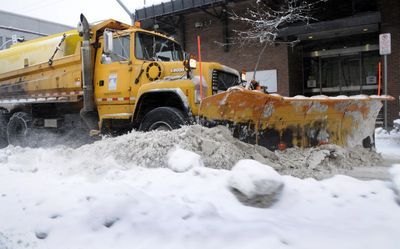Snowplow drivers weary after slew of 12-hour days

For 18 days, many city and county plow drivers have worked 12-hour shifts without a day’s break.
Street officials hope that a warming trend expected this week will allow them to go back to a normal 40-hour schedule. But another storm predicted for tonight may not allow it.
“They’re getting real rummy,” said Spokane Street Director Mark Serbousek, adding that supervisors look for drivers who need a day off.
“If they start getting like they’re not really with it, they’ll pull them,” Serbousek said.
Still, much of the street removal work force has worked without a day off, he said. Crews have plowed most residential streets three times, not to mention the numerous passes along arterials and one clearing of downtown berms.
“I’ve worked here 33 years, and this is going on our longest” Condition Red snow event, said Street Supervisor Shane Thornton. Condition Red is the term the city uses when street crews are ordered to seven-day schedules with 12-hour shifts.
But this may not be the longest stretch in city history. Thornton said when he started working at the street department, old-timers bragged about a 30-day-in-a-row schedule during a tough winter in the late 1960s.
The schedule gets stressful because drivers can’t fulfill their normal family obligations, Thornton said.
Drivers go home, shovel snow off sidewalks, eat a meal and go to bed.
“It becomes like a single-parent home at home,” Thornton said.
Still, there’s a financial reward.
In a full week of a Condition Red operation, a plow driver works 84 hours; 44 of those are overtime, paid at time and a half.
The city asked for volunteers to work on Christmas and New Year’s, with double-time pay. Shifts easily filled.
“The paycheck is nice, but money isn’t everything,” said Curtis Borders, who has worked for the street department for three years. “I’m looking forward to going back to my four 10s.”
Borders said that as time has gone on there’s been an increase in minor accidents. He attributes the rise, in part, to the long hours without a day off. Still, he said, drivers are doing the best they can, and there’s been no complaining.
“All of them take pride in what they are doing,” Borders said.
Last month, Public Works Director Dave Mandyke estimated that each day of Condition Red snow removal costs the city $220,000 – a figure that includes street workers’ regular salaries that would be paid regardless. About a week ago that amount dipped closer to $150,000, after officials discontinued an unprecedented effort at clearing downtown snow berms using city and contracted dump trucks.
Serbousek said that with huge snowfalls in back-to-back winters, he’s hopeful the city will consider new parking rules during plowing. Some cities, for instance, prohibit parking on one side of the street.
Parked cars have limited plow drivers’ maneuverability in neighborhoods, and some streets are skipped because there’s not enough room with parked vehicles and huge berms, Serbousek said.
Borders also hopes for city action to help with plowing.
“The city should really start getting tough on abandoned vehicles,” Borders said. “Sometimes you can’t tell if it’s a berm or a car.”
Even without parked cars, significant berms are narrowing streets and reducing the number of traffic lanes.
That’s causing longer commutes, Serbousek said. To help ease jams, the city is lengthening green-light time at some intersections.
County crews, which plow outside city limits and within Spokane Valley, also have been working continual 12-hour shifts.
“They’re getting tired,” said County Engineer Bob Brueggeman. “They know what their job is, and they’re doing a good job.”